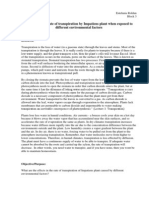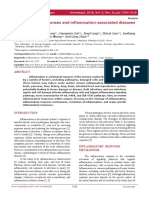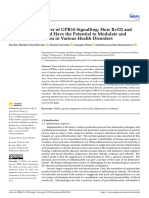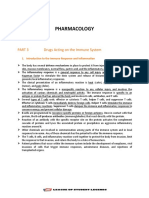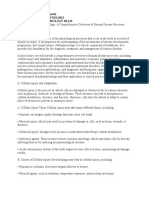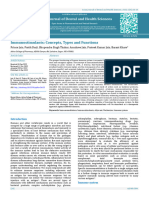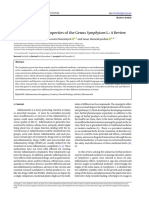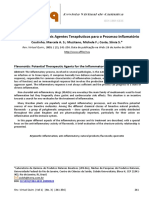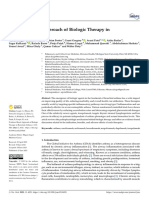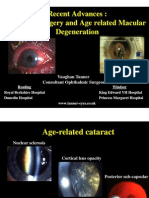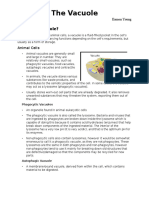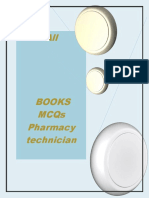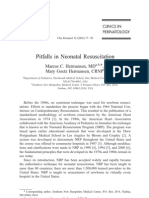Professional Documents
Culture Documents
Inflammation in Health and Disease: Novel Therapeutic Approaches
Inflammation in Health and Disease: Novel Therapeutic Approaches
Original Title
Copyright
Available Formats
Share this document
Did you find this document useful?
Is this content inappropriate?
Report this DocumentCopyright:
Available Formats
Inflammation in Health and Disease: Novel Therapeutic Approaches
Inflammation in Health and Disease: Novel Therapeutic Approaches
Copyright:
Available Formats
Volume 9, Issue 4, April – 2024 International Journal of Innovative Science and Research Technology
ISSN No:-2456-2165 https://doi.org/10.38124/ijisrt/IJISRT24APR1164
Inflammation in Health and Disease: Novel
Therapeutic Approaches
M. Ganga Raju*; G. Kaveri; N.V. L.V. Suvarchala Reddy; P. Manasa, B. Archana
Department of Pharmacology, Gokaraju Rangaraju College of Pharmacy, Bachupally, Hyderabad, Telangana, India
Corresponding Author:
Dr. M. Ganga Raju,
Professor and Principal,
Department of Pharmacology,
GRCP, Hyderabad, Telangana State.
Abstract:- Inflammation, which is regarded as an innate Inflammation, a component of the immune response, is
immune mechanism, is a part of the intricate biological crucial for protecting the body from pathogens like bacteria,
reactions of a tissue to injury that shield the organ by fungus, viruses, and other parasites [5]. However, an
eliminating harmful stimuli and starting the healing unchecked inflammatory response is the primary cause of a
process. The majority of non-steroidal anti- wide range of disorders, including cancer, autoimmune
inflammatory medications on the market work well for diseases, allergies, cardiovascular dysfunction, metabolic
inflammatory diseases. Several compounds that disrupt syndrome, and metabolic disorders, which have a significant
the inflammatory response have also been identified in financial impact on both the individual and the larger society
Indian Medicinal Plants (IMP). The multitude of side [6]. Infections by bacteria, viruses, or fungi that enter the
effects associated with the anti-inflammatory body, settle in specific tissues, or move through the
medications now on the market has a negative impact on bloodstream typically result in inflammation [7-9].
human well-being. Advent of novel anti-inflammatory Inflammation is primarily caused by both the innate and
therapies such as herbal preparations, recent adaptive immune responses. The primary defense system
developments in the use of bioactive ingredients from against cancer cells and invasive microbes is the innate
herbal remedies to treat osteoarthritis and in the immune system, which is composed of mast cells, dendritic
application of synthetic COX-2 inhibitors, chitosan as a cells, and macrophages. More specialized lymphocytes, such
therapy for oral mucosal irritation, improvement in the B and T cells, are involved in the adaptive immune system
medication used to treat acute pancreatitis, extracellular [7,10,11]. Numerous treatments are available for managing
vesicles from mesenchymal cells for the therapy of and repressing inflammatory crises; examples of these
inflammation, oral colonic drug delivery methods for include immunosuppressants, steroids, and non-steroid anti-
treating inflammatory bowel disease and combined inflammatory pharmaceuticals. However, several of these
targeting therapy for inflammatory bowel management medications have negative side effects. In actuality, though,
will not only effectively manage the inflammation and its we want to use the lowest possible effective dose while
associated disorders but also helps to significantly maintaining the greatest level of efficacy and minimizing
improve the quality of life. Hence the current review side effects. In order to maximize pharmaceutical efficacy
reveals the recent advances in the field of inflammation and minimize undesirable side effects, we must therefore
and anti-inflammatory activity in detail. incorporate natural anti-inflammatory components into
medicine therapy [6,12]. Inflammation can be caused by a
Keywords:- Inflammation, Anti-Inflammatory Activity, wide range of substances, but the most common ones are
Recent Advances. infections brought on by bacteria, viruses, or fungi; wounds,
cuts, or scrapes; damage to the body from foreign objects,
I. INTRODUCTION such as a splinter or thorn in the finger; and the effects of
toxic compounds, chemicals, or radiation [13].
The term "inflammation," which comes from the Latin
word "inflammare," which means "to set fire," refers to our
body's defensive reaction to harmful stimuli like allergens
and/or tissue damage [1,2]. An internal or external infection,
irritation, or damage can cause inflammation, which is a
localized reaction characterized by redness, warmth,
swelling, and pain [3]. The intricate biological reaction of
vascular tissues to damaging stimuli such as pathogens,
irritants, or damaged cells is known as inflammation. It is an
attempt on behalf of the organism to both eliminate harmful
stimuli and start the tissue's healing process [4]. Fig 1: Inflammation
IJISRT24APR1164 www.ijisrt.com 990
Volume 9, Issue 4, April – 2024 International Journal of Innovative Science and Research Technology
ISSN No:-2456-2165 https://doi.org/10.38124/ijisrt/IJISRT24APR1164
The two stages of the inflammatory process are acute Monocytes/macrophages, neutrophils, platelets, and mast
and chronic, and both are recognized to be complex cells are among the cells that mediate them, along with
processes that are brought on by various chemical plasma protein. A variety of receptors, including those
mediators, such as prostaglandins, leukotrienes, platelet involved in vascular muscle contraction, direct permeability,
activating factor, etc. [14] neutrophil chemotaxis, smooth enzymatic activity
stimulation, induced pain, and mediated oxidative stress, are
A. Acute Inflammation: bound by chemical mediators, which are produced by viral
It can manifest as redness, heat, or oedema, and it or host proteins. When an inflammatory response occurs, a
typically appears minutes or hours after tissue damage. It is wide variety of inflammatory mediators are created and
a quick procedure. Fluids and plasma proteins exude from released. The pro- and anti-inflammatory groups of
the wounded area, and leukocytes particularly neutrophils chemicals are typically used to categorize compounds that
move in. The defensive mechanism that seeks to eradicate cause inflammation. Still, some mediators have both pro-
bacteria, viruses, and parasites benefits from this acute and anti-inflammatory qualities, such as interleukin (IL)-12.
inflammatory response [15,16]. Acute inflammation goes Many inflammatory mediators and cellular pathways have
away when the immune system successfully gets rid of been thoroughly investigated in relation to pathological
harmful substances; if not, a chronic phase develops. diseases in humans. Two general categories of chemical
Diseases including psoriasis, multiple sclerosis, rheumatoid mediators can be distinguished:
arthritis, persistent asthma, and inflammatory bowel disease
can all be brought on by cascades of inflammation [17]. Mediators Generated from Cells:
Vasoactive amines (Histamine, neuropeptides, and 5-
B. Chronic Inflammation: hydrocyhistamine)
It is longer-lasting and associated with lymphocytes Arachidonic acid metabolites (Eicosanoids)
and macrophages present histologically, which causes Metabolite through cyclo-oxygenase pathway
fibrosis and necrosis of the tissue. Chronic inflammation (Prostaglandins, thromboxane A2, Prostacyclin,
promotes the development of degenerative illnesses, resolvins)
including multiple sclerosis, diabetes, aging, Alzheimer's, Metabolites metabolism through lipo-oxygenase
asthma, rheumatoid arthritis, atherosclerosis, heart disease, pathway (5-HETE, leukotrienes, lipoxins)
cancer, congestive heart failure, multiple sclerosis, gout, and Lysosomal components (from PMNS, macrophages).
other neurodegenerative CNS depressions. Additionally, Platelet activating factor
aging-related muscle loss has been linked in part to chronic Cytokines which include IL-1, TNF-α, TNF-β, TNF-γ,
inflammation [18,19]. Vascular growth, fibrosis, tissue chemokines.
damage, and the presence of lymphocytes and macrophages Free radicals (oxygen metabolites, nitric oxide)
are all linked to chronic inflammation. Chronic infections
and inflammation have been found to be important risk Mediators Derived from Plasma:
factors for a number of cancer types in experimental and The Kinin system
clinical research as well as epidemiological observations The Clotting system
[17]. The Fibrinolytic system
The Complement system [14]
II.RECENT ADVANCES IN THE FIELD OF
INFLAMMATION AND ANTI-INFLAMMATORY
ACTIVITY
Need for Development of New Anti-Inflammatory Agents
The existing anti-inflammatory drugs reported to
possess an array of side effects which adversely effects the
quality of life of the mankind. Advent of new interventions
for inflammation will not only effectively manage the
inflammation and its associated disorders but also helps to
significantly improve the quality of life. Recently attempts
were being made to develop new avenues for controlling
inflammation and finding new targets. Some of them were
enlisted below:
A. Herbal Preparations:
Fig 2: Acute and Chronic inflammation In order to treat disease, maintain health, and
reestablish the body's natural ability to defend, regulate, and
Chemical mediators play a crucial part in the repair itself, herbal therapy typically employs different plant
inflammatory process and are the substances that tend to components or botanical extract mixes [20] Several herbal
steer it, which makes comprehending them comprehensive. anti-inflammatory remedies have been shown in a few
IJISRT24APR1164 www.ijisrt.com 991
Volume 9, Issue 4, April – 2024 International Journal of Innovative Science and Research Technology
ISSN No:-2456-2165 https://doi.org/10.38124/ijisrt/IJISRT24APR1164
clinical investigations to be effective in treating between herbal medicines and synthetic preparations, as
inflammation with little adverse effects (see table 1). There well as serious side effects from several of them [21].
are reports of major negative effects and interactions
Table 1: Clinical Trials on Selected Herbal Extract
S.no Herbal formulation Type of trial Inference
1) Ethyl acetate extract of purified Randomized and double-blind trial No adverse effects during the analgesic and
(gugulu commiphora mukul) digestive phases
2) Turmeric extract Large, double-blind study Osteoarthritis and rheumatoid arthritis
3) Boswellia serrate extract Randomized, double-blind, verum Decreased inflammatory response when
controlled, parallel group treating Crohn's illness
4) White willow bark extract A four-week crossover study that Treatment for acute episodes of persistent
was double-blind and placebo- lower back pain in the short term.
controlled
5) Ethanolic extract of Devil’s Randomized, double-blind, parallel Increased effectiveness in treating
claw group study rheumatism, lower back pain, and knee and
hip pain associated with osteoarthritis.
B. Recent Developments in The Use of Bioactive insufficient when compared to other types of arthritis, such
Ingredients From Herbal Remedies To Treat as rheumatoid arthritis (RA). There are certain
Osteoarthritis: pathophysiological similarities between RA and OA,
In recent research, 43 herbal substances with anti-OA including oxidative stress, apoptosis, and inflammation.
properties were examined in relation to the treatment of Thus, future studies will examine the possibility of anti-RA
osteoarthritis (OA). For the treatment of osteoarthritis (OA), medications in the management of OA [22].
articular cartilage, subchondral bone, synovial membrane,
muscle, and circulatory system are the primary therapeutic Heterocyclic compounds as anti-inflammatory agents
sites of these molecules. There is potential for additional Various families of heterocyclic compounds, including
research and development as more than half of these pyrazole, pyrimidine, benzimidazole, indole, and others,
compounds have good drug-like characteristics. Based on have been identified as heterocyclic anti-inflammatory
cheminformatics analysis, these constituents' drugs. These compounds can be classified as non-selective,
pharmacokinetic behaviour still need refinement, which will COX-2 selective, LOX selective, or COX/LOX dual
help to improve their drug-like qualities. In the treatment of inhibitors. Table 2 lists the lead drugs with varying stages of
osteoarthritis, the use of herbal substances has advanced clinical studies against inflammation [23].
somewhat. Yet, the use of herbal remedies in OA is still
Table-2: Clinical trials on novel compounds
S.no Novel compound Indications Clinical trial reference
1 Bromfenac and Extra (pulse) dose on the day of surgery for treatment of ocular NCT0239465
Nepafenac inflammation associated with cataract surgery.
2 Escitalopram Analyse its impact on inflammation-causing depression NCT02389465
3 Propofol To assess how it affects the inflammatory process by regulating NCT01115179
Apo A-1
4 Captopril Both alone and in conjunction with telmisartan to combat a NCT01271478
patient's systemic inflammation while receiving hemodialysis
5 Riluzole and Clinical advancements NCT02074462
Dexlansoprazole NCT01093755
6 Oral vitamin C Evaluation in opposition to inflammation NCT01356433
Developments in the Application of Synthetic COX-2 rofecoxib such as anti-inflammatory activity, gastrointestinal
Inhibitors: protection, and a safer profile [24].
The researchers found biological activity of synthetic
COX-2, dual COX-2/lipoxygenase, and COX-2/soluble Chitosan as a Therapy for Oral Mucosal Irritation:
epoxide hydrolase hybrid inhibitors, which offer a number Chitosan may lessen discomfort and promote better
of benefits over NSAIDs like celecoxib, valdecoxib, and oral lesion healing in patients with oral mucositis (OM),
IJISRT24APR1164 www.ijisrt.com 992
Volume 9, Issue 4, April – 2024 International Journal of Innovative Science and Research Technology
ISSN No:-2456-2165 https://doi.org/10.38124/ijisrt/IJISRT24APR1164
recurrent aphthous stomatitis (RAS), and denture stomatitis involve clarifying the molecular causes of IBD disorders and
(DS). There is insufficient data to definitively support conducting additional in vivo tests to confirm the stability
chitosan's superiority over other available treatments for oral and specificity of the developed systems [29].
mucositis, and their high risk of bias and poor quality
exclude any suggestion about their therapeutic use [25]. Combined Targeted Therapy for Inflammatory Bowel
Disease Management:
New Lead Structures with Anti-Inflammatory Properties: Treating IBD patients with combined biological or
Several alluring therapeutic targets, agents, and small-molecule medicines that target diverse sites creates a
diagnostic indicators for the treatment of inflammatory new therapeutic option. There is growing data on
disorders. The signalling pathway proteins, transcriptional combination target therapy in two clinical scenarios: "double
factors (such as nuclear receptors), oncogenes, and lncRNA indication," with active EIMs, and "complex refractory
make up these biomarkers and targets. O-substituted IBD," when no mono therapeutic approach proved effective.
tryptanthrin oxime derivatives are an example of a synthetic For bio-naïve IBD patients, combination targeted therapy is
compound. Natural substances that are therapeutic agents not yet advised outside of clinical trials. It's uncertain if
include ginsenoside Rc and others. Along with defining combination therapy should be used as maintenance therapy
complex gene-chemical connections, the researchers also or just during the induction phase. Recent results from the
outlined molecular pathways involved in the genesis of VEGA trial suggested that golimumab and guselkumab, two
inflammatory illness. For the future management of innovative biologics, might be used together as a new kind
inflammatory illnesses, our work may produce novel anti- of treatment for individuals with high-risk UC [30].
inflammatory lead structures with established
pharmacokinetics and efficacy in vivo. A more targeted and III. CONCLUSION
efficient approach to treating disease states would come
from more research to determine which patients might Established therapeutic anti-inflammatory drugs
benefit from a specific anti-inflammatory medication possess few adverse effects which slowly discriminating its
activity [26]. use. Hence it is concluded that few recent advances in the
therapy of inflammation might reduce the established side
Improvements in the Medication Used to Treat Acute effects with more efficacy and long-term use. Further
Pancreatitis: studies are required to provide a better mechanistic view.
In order to validate their application in clinical
practice, the discovered prospective therapeutics for acute ACKNOWLEDGEMENTS
pancreatitis (AP) are awaiting additional development and
clinical evaluation from big trials. Future research efforts The authors are grateful to the Principal Prof. M.
must center on these three critical areas of AP management: Ganga Raju and Management of the Gokaraju Rangaraju
early diagnosis, risk stratification, and efficacious treatment College of Pharmacy, for the constant support and
strategies. These components are essential to changing the encouragement during the course of the work.
trajectory of the disease. In order to develop effective
treatments for AP, therapeutic targets that influence illness REFERENCES
severity and outcomes must be identified and assessed in the
patient population through standardized clinical trials with [1]. Denko CW. A role of neuropeptides in inflammation.
well-defined objectives in the future [27]. In: Whicher JT, Evans SW, editors. Biochemistry of
inflammation. London: Kluwer Publisher; pp. 177-81,
Extracellular Vesicles from Mesenchymal Stromal Cells 1992.
for the Therapy of Inflammation: [2]. Singh A, Malhotra S, Subban R. Anti-inflammatory
Improved efficacy and robustness of EVs are vital, as and analgesic agents from Indian medicinal plants. Int
is standardizing EV production and isolation procedures. J Integ Biol. Vol 3: pp. 57-72, 2008.
MSC-derived extracellular vesicles (EVs) have been used as [3]. Karthik Kumar, what are the five classical signs of
anti-inflammatory and pro-regenerative agents in a variety inflammation, 2023, online available from
of inflammation-related conditions, including osteoarthritis, http://www.medicinenet.com/script/main/art.asp?article
rheumatoid arthritis, Alzheimer's disease, cardiovascular key=3979
disease, and preeclampsia. These EVs have regenerative [4]. Denko, C.W. A role of neuropeptides in inflammation.
effects on damaged or diseased tissues, especially when In: Whicher, J. T. and Evans, S. W. Biochemistry of
applied locally in large doses [28]. Inflammation. Kluwer Pub. London. pp. 77-181 1992.
[5]. Mayer, L. and Bhikha, R. Nature and Role of
Oral Colonic Drug Delivery Methods for Treating Inflammation-Benefits and Drawbacks, 2023.
Inflammatory Bowel Disease: [6]. Bagad, A.S, Joseph J. A, Agarwal A. Comparative
The release of particular enzymes, reactive oxygen evaluation of anti-inflammatory activity of
species (ROS), pH, or a combination of these causes an curcuminoids, turmerones, and aqueous extract of
increase in the development of CDDS. With fewer side Curcuma longa. Advances in Pharmacological
effects, these administration methods showed an Sciences, vol 7, pp. 56-58, 2002.
improvement in therapy. In order to develop more targeted [7]. Artis, D. Spits, H. The biology of innate lymphoid
treatments, future approaches to treating this illness may cells. Nature, vol 517, pp. 293–301, 2015.
IJISRT24APR1164 www.ijisrt.com 993
Volume 9, Issue 4, April – 2024 International Journal of Innovative Science and Research Technology
ISSN No:-2456-2165 https://doi.org/10.38124/ijisrt/IJISRT24APR1164
[8]. Isailovic, N. Daigo, K. Mantovani, A. Selmi, C. [24]. Ahmadi M, Bekeschus S, Weltmann K, Woedtke T and
Interleukin-17 and innate immunity in infections and Wende K, Non-steroidal anti-inflammatory drugs:
chronic inflammation. J. Autoimmune, vol 60, pp. 1– recent advances in the use of synthetic COX-2
11, 2015. inhibitors This journal is © The Royal Society of
[9]. Pedraza-Alva, G.; Pérez-Martínez, L.; Valdez- Chemistry RSC Med. Chem., vol 13, pp. 471–496,
Hernández, L.; Meza-Sosa, K.F.; Ando-Kuri, M. 2020
Negative regulation of the inflammasome: Keeping [25]. Zúñiga-López C, Márquez-Pérez K, Argueta-Figueroa
inflammation under control. Immunol. Rev. vol 265, L, Hernández M, Torres-Rosas R, Chitosan for the
pp. 231–257, 2015. treatment of inflammation of the oral mucosa: A
[10]. Rock K.L., Lai J.J., Kono H. Innate and adaptive systematic review Oral Medicine and Pathology
immune responses to cell death. Immunol. Rev. vol eISSN: 1698-6946, 2024
243: pp. 191–205 2011. [26]. Li F, Wang S, Chao X and Wang S. editorial: recent
[11]. Waisman A., Liblau R.S., Becher B. Innate and advances in novel therapeutic molecules and targets for
adaptive immune responses in the CNS. LancetNeurol. inflammatory diseases frontiers in pharmacology
14:945–955, 2015. 10.3389/fphar. 1121821, 2022.
[12]. Ghasemian M and Owlia MB. A different look at [27]. Hey-Hadavia J, Velisettyb P and Mhatrec S, Trends
pulsed glucocorticoid protocols; is high dose oral and recent developments in pharmacotherapy of acute
prednisolone really necessary just after initiation of pancreatitis vol135, no. 4, pp. 334–344, 2023
pulse therapy? Journal of Case Reports in Practice, vol [28]. T. Ryan S, Hosseini-Beheshti E, Afrose D, Ding X, Xia
3, no (1), 2015. B, Georges E. Grau, Christopher B. Little, Mc
[13]. InformedHealth.org [Internet]. National library of Clements L and Jiao Jiao Li, Extracellular Vesicles
science 2010, Institute for Quality and Efficiency in from Mesenchymal Stromal Cells for the Treatment of
Health Care. What is an inflammation? Inflammation-Related Conditions international journal
[14]. Azab A, Nassar A, and N. Azab A, Anti-inflammatory of molecular science Mol. Sci. vol 22, pp. 3023, 2021
activity of natural products National library of [29]. H. Teruel A, Gonzalez-Alvarez I, Bermejo M, Merino
medicine vol 21, no (10), pp. 1321, 2016. V, Dolores Marcos M, Sancenon F, Gonzalez-Alvarez
[15]. Rajyalakshmi MS. Acute Inflammation, SRM M and Martinez-Mañez R, New Insights of Oral
University, 4-10. Colonic Drug Delivery Systems for Inflammatory
[16]. Rajyalakshmi MS. Chronic Inflammation, SRM Bowel Disease Therapy international journal of
University, 43-47 molecular sciences, vol 21, pp. 6502, 2020
[17]. Mantovani, A. Pierotti, M.A. Cancer and inflammation: [30]. Wetwittayakhlang P, L. Lakatos P, Current Evidence
A complex relationship. Cancer Lett. vol 267, pp. 180– for Combined Targeted Therapy for the Treatment of
181, 2008. Inflammatory Bowel Disease Journal of the Canadian
[18]. Mona S. Mohammed, Wadah J.A. Osman, Elrashied Association of Gastroenterology, vol 7, pp. 22–29,
A.E. Garelnabi, Zuheir Osman, Bashier Osman, 2024
Hassan S. Khalid, Magdi A. Mohamed, Secondary
metabolites as anti-inflammatory agents. Journal of
Phytopharmacology, vol 3, no (4), pp. 275-285, 2014.
[19]. Ilango K, Maharajan G, Narasimhan S, Anti-
nociceptive and anti-inflammatory activities of
Azadirachta indica fruit skin extract and its isolated
constituent azadiradione, Natural Product Research,
vol 27, pp. 1463-7, 2012.
[20]. Drew, A.K. Myers, S.P, Safety issues in herbal
medicine: implications for the health professions.
WHO Report. Available from: https://
www.mja.com.au/public/issues/may19/drew/drew.html
. [cited in 1997]. [accessed on Oct 26 in 2009]
[21]. Beg S, Swain S, Hasan H, Abul Barkat M, Sarfaraz
Hussain Md, Systematic review of herbals as potential
anti-inflammatory agents: Recent advances, current
clinical status and future perspectives Phcog Rev vol 5,
pp. 120-37, 2011
[22]. Xu-zhao Li and Zhang S, Recent advances in treatment
of osteoarthritis by bioactive components from herbal
medicine vol 15, pp. 80, 2020.
[23]. Sharma S, Kumar D, Singh G, Monga V, Kumar B,
Recent advancements in the development of
heterocyclic anti-inflammatory agents European
Journal of Medicinal Chemistry 200,112438, 2020.
IJISRT24APR1164 www.ijisrt.com 994
You might also like
- Pathophysiology of SepsisDocument8 pagesPathophysiology of SepsisntnquynhproNo ratings yet
- Kryptonian Codex Backup - 2 7-21-14 (2015 - 08 - 13 16 - 29 - 16 UTC)Document140 pagesKryptonian Codex Backup - 2 7-21-14 (2015 - 08 - 13 16 - 29 - 16 UTC)Stephanie B100% (2)
- Preventive MedicineDocument29 pagesPreventive MedicineEliDavidNo ratings yet
- Men's Fitness - March 2017 UKDocument132 pagesMen's Fitness - March 2017 UKbuzbonNo ratings yet
- Hema, Onco, Cardiology Review NotesDocument9 pagesHema, Onco, Cardiology Review Notesjeshema100% (1)
- Carbohydrate Metabolism - MCQ On Glycolysis & GluconeogenesisDocument13 pagesCarbohydrate Metabolism - MCQ On Glycolysis & Gluconeogenesisolayemi mariamNo ratings yet
- Lab Report TranspirationDocument7 pagesLab Report Transpirationapi-255945341100% (1)
- YogaTherapyforDigestiveHealth PDFDocument3 pagesYogaTherapyforDigestiveHealth PDFrabirm77No ratings yet
- Stress-Induced (Takotsubo) CardiomyopathyDocument13 pagesStress-Induced (Takotsubo) CardiomyopathyAdrian GeambasuNo ratings yet
- Osmosis in Plant CellDocument8 pagesOsmosis in Plant CellsandalailaNo ratings yet
- Inflammation LRDocument12 pagesInflammation LRMahnoor MansoorNo ratings yet
- Enviar JayneDocument14 pagesEnviar JayneLarissa PereiraNo ratings yet
- Ijms 20 04367Document38 pagesIjms 20 04367Rio TamayoNo ratings yet
- Sysmex SEED Haematology InflammatoryDocument7 pagesSysmex SEED Haematology InflammatoryTzeto Han CongNo ratings yet
- 1 s2.0 S0753332220311513 MainDocument18 pages1 s2.0 S0753332220311513 MainAnita DewiNo ratings yet
- Tutorial 2 Hit The WallDocument19 pagesTutorial 2 Hit The WallSeyna OfficialNo ratings yet
- Chronic Inflammatory Diseases, Anti-Inflammatory Agents and Their Delivery NanosystemspdfDocument27 pagesChronic Inflammatory Diseases, Anti-Inflammatory Agents and Their Delivery NanosystemspdfDeddy TrimarwantoNo ratings yet
- Etiology InflammationDocument15 pagesEtiology InflammationYeni RahmawatiNo ratings yet
- JPM 13 01479Document16 pagesJPM 13 01479Andreea RacovitaNo ratings yet
- MoleculesDocument27 pagesMoleculesEwelina HonkiszNo ratings yet
- Role of Herbals As Anti-Cancer and Anti-Inflammatory AgentsDocument11 pagesRole of Herbals As Anti-Cancer and Anti-Inflammatory AgentsInternational Journal of Innovative Science and Research TechnologyNo ratings yet
- Immune System: From Wikipedia, The Free EncyclopediaDocument75 pagesImmune System: From Wikipedia, The Free EncyclopediaDewi PratiwiNo ratings yet
- Reviews: Modulating Immunity As A Therapy For Bacterial InfectionsDocument12 pagesReviews: Modulating Immunity As A Therapy For Bacterial InfectionsZineb RAISNo ratings yet
- 8824 Manuscrito 51760 2 10 20220523Document8 pages8824 Manuscrito 51760 2 10 20220523saludNo ratings yet
- The Role of Viral Infections in The Onset of Autoimmune DiseaseDocument31 pagesThe Role of Viral Infections in The Onset of Autoimmune DiseaseLuis RiveraNo ratings yet
- Understanding Anti-Inflammatory DrugsDocument4 pagesUnderstanding Anti-Inflammatory DrugsMark Russel Sean LealNo ratings yet
- Immunological Changes With Age and Innovative Approaches To Bolster Immune Function in Older AdultsDocument11 pagesImmunological Changes With Age and Innovative Approaches To Bolster Immune Function in Older AdultsKIU PUBLICATION AND EXTENSIONNo ratings yet
- Calder 2013Document34 pagesCalder 2013Lastrie BuluatieNo ratings yet
- Treatment of Endodontic Infections-109-157Document49 pagesTreatment of Endodontic Infections-109-157Kirana YosandraNo ratings yet
- PHARMACOLOGY-Drugs Acting On The Immune SystemDocument12 pagesPHARMACOLOGY-Drugs Acting On The Immune SystemMarianne Joyce ManzoNo ratings yet
- Understanding PathophysiologyDocument8 pagesUnderstanding PathophysiologyMark Russel Sean LealNo ratings yet
- Immunostimulants Concepts Types and FunctionsDocument9 pagesImmunostimulants Concepts Types and FunctionsNatasha Alexandra MolinaNo ratings yet
- Origin and Physiological Roles of InflammationDocument8 pagesOrigin and Physiological Roles of InflammationLuis VazquezNo ratings yet
- Theunis, Louise Immunotherapeutics CapstoneDocument4 pagesTheunis, Louise Immunotherapeutics CapstoneLouise TheunisNo ratings yet
- Ar FisiopatologiaDocument10 pagesAr FisiopatologiaEdyson SedanoNo ratings yet
- Afsar Ahmed FIB 0274 10123 AUA OffprintDocument9 pagesAfsar Ahmed FIB 0274 10123 AUA Offprintananta restyNo ratings yet
- In Vitro Antioxidant and Anti-Inflammatory Potential ofDocument13 pagesIn Vitro Antioxidant and Anti-Inflammatory Potential ofSabrina JonesNo ratings yet
- Sterile Inflammation - Sensing andDocument12 pagesSterile Inflammation - Sensing andJOHN HELIBERTH ANDREY TORRES GRANADOSNo ratings yet
- الكومفريDocument15 pagesالكومفريMuna MuhNo ratings yet
- Host ModulationDocument20 pagesHost Modulationdhwanit31No ratings yet
- Antibiotics 13 00406Document14 pagesAntibiotics 13 00406aragonfenixNo ratings yet
- Immune SystemDocument17 pagesImmune SystemRomneck RoveroNo ratings yet
- Ox InflammationDocument15 pagesOx Inflammationcc vereNo ratings yet
- Anti-Inflammatory and Immunoregulatory Action of Sesquiterpene Lactones. Molecules-27-01142Document23 pagesAnti-Inflammatory and Immunoregulatory Action of Sesquiterpene Lactones. Molecules-27-01142JuanAntonio ToroNo ratings yet
- Recombinant Peptide Subunit Vaccine Covid 19Document6 pagesRecombinant Peptide Subunit Vaccine Covid 19Marcelo Ricci UvinhaNo ratings yet
- Nutrients 14 00612Document17 pagesNutrients 14 00612Miguel RuizNo ratings yet
- UddayDocument21 pagesUddayJune DumdumayaNo ratings yet
- Pathophysiologyofsepsis Up To DateDocument24 pagesPathophysiologyofsepsis Up To DateTom CoutinhoNo ratings yet
- Immunopathogenesis of Delayed-Type HypersensitivityDocument5 pagesImmunopathogenesis of Delayed-Type Hypersensitivityrochmandrg dokter gigiNo ratings yet
- Thanavala 2-23-17 Mir 508 Adv Immunol Yt Inflammation 2017Document27 pagesThanavala 2-23-17 Mir 508 Adv Immunol Yt Inflammation 2017kaoutherboublatNo ratings yet
- Preprints202003 0199 v1Document9 pagesPreprints202003 0199 v1Pablo HernandezNo ratings yet
- J. Antimicrob. Chemother. 2012 Kovaleva 530 40Document11 pagesJ. Antimicrob. Chemother. 2012 Kovaleva 530 40Bases De Datos MédicasNo ratings yet
- Adverse Drug Reactions and Organ Damage The SkinDocument8 pagesAdverse Drug Reactions and Organ Damage The SkinKOAS YES JOSNo ratings yet
- 182409Document2 pages182409المكعب الذهبي - The Golden CubeNo ratings yet
- Extracorporeal-Immuno Of-Autoimmune-Dis - Jcei-19Document5 pagesExtracorporeal-Immuno Of-Autoimmune-Dis - Jcei-19EliDavidNo ratings yet
- Inflammatory Mechanisms: The Molecular Basis of Inflammation and DiseaseDocument7 pagesInflammatory Mechanisms: The Molecular Basis of Inflammation and DiseaseMaximeNo ratings yet
- Anti-Inflammatory Activity of Traditional Chinese Medicinal HerbsDocument17 pagesAnti-Inflammatory Activity of Traditional Chinese Medicinal HerbsyohanNo ratings yet
- Amirhofran, 2012Document9 pagesAmirhofran, 2012intansofiairsaNo ratings yet
- Flavonoides - Potenciais Agentes Terapêuticos para o Processo InflamatórioDocument16 pagesFlavonoides - Potenciais Agentes Terapêuticos para o Processo InflamatórioRenan Guilherme de Oliveira GuihNo ratings yet
- An Overview of Immunology Systemicreview PDFDocument17 pagesAn Overview of Immunology Systemicreview PDFMohmed AttiaNo ratings yet
- Rheumatic Diseases Induced by Drugs and Environmental Factors Part 2Document5 pagesRheumatic Diseases Induced by Drugs and Environmental Factors Part 2manuel martinezNo ratings yet
- OJDOH - ms.ID.000638 2puplished AllergicDocument6 pagesOJDOH - ms.ID.000638 2puplished Allergicshayma rafatNo ratings yet
- Source:Immunology Eight Edition David MaleDocument3 pagesSource:Immunology Eight Edition David MaleAzzahra FadhlilaNo ratings yet
- Seminario ArtículoDocument20 pagesSeminario Artículomarixa ledesmaNo ratings yet
- Challenging The Theory of Artificial ImmunityDocument7 pagesChallenging The Theory of Artificial ImmunityKeith Wassung100% (2)
- JCM 12 04321 v2Document12 pagesJCM 12 04321 v2martalia taliaNo ratings yet
- Stacey Oke. The Inflmmatory ReflexDocument13 pagesStacey Oke. The Inflmmatory ReflexSantiago RosslerNo ratings yet
- Antioxidants: Nutraceuticals Against Oxidative Stress in Autoimmune DisordersDocument28 pagesAntioxidants: Nutraceuticals Against Oxidative Stress in Autoimmune DisordersTibério VasconcelosNo ratings yet
- The Impact of Store Atmosphere and Customer Experience on Consumer Purchasing Decisions of KFC Wahidin GresikDocument5 pagesThe Impact of Store Atmosphere and Customer Experience on Consumer Purchasing Decisions of KFC Wahidin GresikInternational Journal of Innovative Science and Research TechnologyNo ratings yet
- An Appraisal of Employable Content of the National Diploma in Architectural Technology Program in North East NigeriaDocument5 pagesAn Appraisal of Employable Content of the National Diploma in Architectural Technology Program in North East NigeriaInternational Journal of Innovative Science and Research TechnologyNo ratings yet
- Study of prevalence of Head Lice (Pediculus Humanus Capitis) Among Schoolchildren in the Zawiya Region, LibyaDocument10 pagesStudy of prevalence of Head Lice (Pediculus Humanus Capitis) Among Schoolchildren in the Zawiya Region, LibyaInternational Journal of Innovative Science and Research Technology0% (1)
- The Impact of the Commercial Agriculture Credit Scheme (CACS) on the Agricultural Economy of Nigeria and its Total Output (2015-2019)Document8 pagesThe Impact of the Commercial Agriculture Credit Scheme (CACS) on the Agricultural Economy of Nigeria and its Total Output (2015-2019)International Journal of Innovative Science and Research TechnologyNo ratings yet
- Thickness CipherDocument3 pagesThickness CipherInternational Journal of Innovative Science and Research TechnologyNo ratings yet
- Human Resource Functions: Examining Insights from ABC Research OrganizationDocument9 pagesHuman Resource Functions: Examining Insights from ABC Research OrganizationInternational Journal of Innovative Science and Research TechnologyNo ratings yet
- Conceptualized Fusion Reactor based on Gas Turbine with High Temperature CO2Document7 pagesConceptualized Fusion Reactor based on Gas Turbine with High Temperature CO2International Journal of Innovative Science and Research TechnologyNo ratings yet
- The Expanding Attack Surface: Securing AI and Machine Learning Systems in Security OperationsDocument8 pagesThe Expanding Attack Surface: Securing AI and Machine Learning Systems in Security OperationsInternational Journal of Innovative Science and Research Technology100% (1)
- Integrating Quantum Algorithms with Gravitational-Wave Metrology for Enhanced Signal DetectionDocument18 pagesIntegrating Quantum Algorithms with Gravitational-Wave Metrology for Enhanced Signal DetectionInternational Journal of Innovative Science and Research Technology100% (1)
- Teacher-Induced Academic Stress: Predicting Eating Behavior Problems in College StudentsDocument8 pagesTeacher-Induced Academic Stress: Predicting Eating Behavior Problems in College StudentsInternational Journal of Innovative Science and Research TechnologyNo ratings yet
- The Impact of Termite Activity on the Availability of Soil Micronutrients in Tropical RegionsDocument6 pagesThe Impact of Termite Activity on the Availability of Soil Micronutrients in Tropical RegionsInternational Journal of Innovative Science and Research Technology100% (1)
- Modern Approaches to Sustainable AgricultureDocument10 pagesModern Approaches to Sustainable AgricultureInternational Journal of Innovative Science and Research Technology100% (1)
- Utilizing Chicken Eggshells and Waste Glass Powder as Cement Fillers for Environmental StabilityDocument6 pagesUtilizing Chicken Eggshells and Waste Glass Powder as Cement Fillers for Environmental StabilityInternational Journal of Innovative Science and Research TechnologyNo ratings yet
- Assessment of Integrated Poultry Manure and Synthetic Fertilizer Effects on Maize (Zea mays) Growth and Soil Properties: A Study from Bayero University, KanoDocument15 pagesAssessment of Integrated Poultry Manure and Synthetic Fertilizer Effects on Maize (Zea mays) Growth and Soil Properties: A Study from Bayero University, KanoInternational Journal of Innovative Science and Research Technology100% (1)
- Unlocking Sentiments: Enhancing IOCL Petrol Pump ExperiencesDocument8 pagesUnlocking Sentiments: Enhancing IOCL Petrol Pump ExperiencesInternational Journal of Innovative Science and Research TechnologyNo ratings yet
- Personal Capabilities of The Non-Teaching Personnel and Client SatisfactionDocument8 pagesPersonal Capabilities of The Non-Teaching Personnel and Client SatisfactionInternational Journal of Innovative Science and Research TechnologyNo ratings yet
- Transforming Challenges to Victories: An Inquiry on Transformational Leadership of School Leaders in the Public Elementary SchoolsDocument54 pagesTransforming Challenges to Victories: An Inquiry on Transformational Leadership of School Leaders in the Public Elementary SchoolsInternational Journal of Innovative Science and Research TechnologyNo ratings yet
- The Influence of Continuance Commitment on Job Satisfaction of Barangay Health Workers in Malaybalay City, BukidnonDocument14 pagesThe Influence of Continuance Commitment on Job Satisfaction of Barangay Health Workers in Malaybalay City, BukidnonInternational Journal of Innovative Science and Research TechnologyNo ratings yet
- Intelligent Clinical Documentation: Harnessing Generative AI For Patient-Centric Clinical Note GenerationDocument15 pagesIntelligent Clinical Documentation: Harnessing Generative AI For Patient-Centric Clinical Note GenerationInternational Journal of Innovative Science and Research TechnologyNo ratings yet
- Solar Based Multilevel Inverter F o R BLDC Motor DriveDocument8 pagesSolar Based Multilevel Inverter F o R BLDC Motor DriveInternational Journal of Innovative Science and Research TechnologyNo ratings yet
- Design and Development of Multi-Featured Medical StretcherDocument4 pagesDesign and Development of Multi-Featured Medical StretcherInternational Journal of Innovative Science and Research TechnologyNo ratings yet
- Meta Land: Redefining Virtual Communities Through Centralized Governance, Inclusivity and InnovationDocument5 pagesMeta Land: Redefining Virtual Communities Through Centralized Governance, Inclusivity and InnovationInternational Journal of Innovative Science and Research TechnologyNo ratings yet
- Exploring The Potential Advantages of Traditional Therapies in Autoimmune Blistering Illnesses: A Comprehensive Review and Analysis, ResearchDocument12 pagesExploring The Potential Advantages of Traditional Therapies in Autoimmune Blistering Illnesses: A Comprehensive Review and Analysis, ResearchInternational Journal of Innovative Science and Research TechnologyNo ratings yet
- Strategic Deployment of Ducklink Wireless Devices For Disaster Mitigation and Management in Nueva ECIJA University of Science and Technology Sumacab CampusDocument13 pagesStrategic Deployment of Ducklink Wireless Devices For Disaster Mitigation and Management in Nueva ECIJA University of Science and Technology Sumacab CampusInternational Journal of Innovative Science and Research TechnologyNo ratings yet
- Seasonal Variation and Distribution Patterns of Endophytic Community in Withania SomniferaDocument7 pagesSeasonal Variation and Distribution Patterns of Endophytic Community in Withania SomniferaInternational Journal of Innovative Science and Research TechnologyNo ratings yet
- Skin Disease Detection and Remedial SystemDocument7 pagesSkin Disease Detection and Remedial SystemInternational Journal of Innovative Science and Research TechnologyNo ratings yet
- EmoConnect: Nurturing Trust and Relationship Bonds in Alzheimer's ConversationsDocument3 pagesEmoConnect: Nurturing Trust and Relationship Bonds in Alzheimer's ConversationsInternational Journal of Innovative Science and Research TechnologyNo ratings yet
- Development of Smart Ground Fault Location Model For Radial Distribution SystemDocument14 pagesDevelopment of Smart Ground Fault Location Model For Radial Distribution SystemInternational Journal of Innovative Science and Research TechnologyNo ratings yet
- Smart and Secure Home With ChatbotDocument9 pagesSmart and Secure Home With ChatbotInternational Journal of Innovative Science and Research TechnologyNo ratings yet
- Preparation and Identification of Magnetic Iron Nanoparticle Based On A Natural Hydrogel and Its Performance in Targeted Drug DeliveryDocument17 pagesPreparation and Identification of Magnetic Iron Nanoparticle Based On A Natural Hydrogel and Its Performance in Targeted Drug DeliveryInternational Journal of Innovative Science and Research TechnologyNo ratings yet
- BIO SAQ's PDFDocument14 pagesBIO SAQ's PDFchloeNo ratings yet
- Cataract Surgery and Age Related Macular Degeneration, Recent Advances, GP and Optometist Update 2010Document73 pagesCataract Surgery and Age Related Macular Degeneration, Recent Advances, GP and Optometist Update 2010Nyndia WeriNo ratings yet
- Managing Stress Through Physical Activity 3rdDocument20 pagesManaging Stress Through Physical Activity 3rdIren Castor MabutinNo ratings yet
- Cointegrated VectorsDocument2 pagesCointegrated Vectorsdevikamurugan124206No ratings yet
- Relationship Between Diet and Stress Levels To Recurrence of Gastritis in The Tarok Puskesmas Work AreaDocument10 pagesRelationship Between Diet and Stress Levels To Recurrence of Gastritis in The Tarok Puskesmas Work AreaApriyanti BadjiserNo ratings yet
- The Vacuole: What Is A Vacuole?Document3 pagesThe Vacuole: What Is A Vacuole?Amber L.No ratings yet
- Cell RiddlesDocument2 pagesCell RiddlesDonabelEscotaEspaño100% (1)
- International Endodontic JournalDocument13 pagesInternational Endodontic Journalrestu dewi lestariNo ratings yet
- AdvDocument215 pagesAdvTousif Haider100% (1)
- Assignment OF PhysiologyDocument20 pagesAssignment OF PhysiologyAhmed KhanNo ratings yet
- Twisting Flow Yoga Sequence A4 FREEDocument1 pageTwisting Flow Yoga Sequence A4 FREEmateriaelementalNo ratings yet
- Nutritional Management of The Critically Ill.29Document16 pagesNutritional Management of The Critically Ill.29Ririn Muthia ZukhraNo ratings yet
- Pitfalls of Neonatal ResuscitationDocument19 pagesPitfalls of Neonatal ResuscitationRME360No ratings yet
- Crafting The Service Environment: Text Book Chapter 10Document25 pagesCrafting The Service Environment: Text Book Chapter 10Sneha DussaramNo ratings yet
- Biology 1st Semester Finals TopicsDocument3 pagesBiology 1st Semester Finals TopicsJaya SeelanNo ratings yet
- Broncho-Pulmonary SegmentsDocument29 pagesBroncho-Pulmonary SegmentsArbin PanjaNo ratings yet
- Lesson 4 PE 11Document55 pagesLesson 4 PE 11John michael SumagaysayNo ratings yet
- The Role of Food in CancerogenesisDocument20 pagesThe Role of Food in CancerogenesisSiti Ika FitrasyahNo ratings yet
- CicaLiquid NH3 - L-020EDocument4 pagesCicaLiquid NH3 - L-020Eandr sonNo ratings yet
- Camouflage Treatment of Skeletal Class III Malocclusion With Asymmetry Using A Bone-Borne Rapid Maxillary ExpanderDocument13 pagesCamouflage Treatment of Skeletal Class III Malocclusion With Asymmetry Using A Bone-Borne Rapid Maxillary ExpanderClinica Dental AdvanceNo ratings yet
- HT Age Based PDFDocument8 pagesHT Age Based PDFDoni TrinandaNo ratings yet






